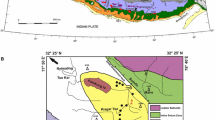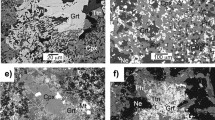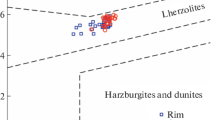Abstract
Grossular-andradite (grandite) garnets, precipitated from hydrothermal solutions is associated with contact metamorphism in the Kal-e Kafi skarn show complex oscillatory chemical zonation. These skarn garnets preserve the records of the temporal evolution of contact metasomatism. According to microscopic studies and microprobe analysis profiles, the studied garnet has two distinct parts: the intermediate (granditic) composition birefringent core that its andradite content based on microprobe analysis varies between 0.68–0.7. This part is superimposed with more andraditic composition, and the isotropic rim which its andradite content regarding microprobe analysis ranges between 0.83–0.99. Garnets in the studied sample are small (0.5–2 mm in diameter) and show complex oscillatory zoning. Electron microprobe analyses of the oscillatory zoning in grandite garnet of the Kal-e Kafi area showed a fluctuation in chemical composition. The grandite garnets normally display core with intermediate composition with oscillatory Fe-rich zones at the rim. Detailed study of oscillatory zoning in grandite garnet from Kal-e Kafi area suggests that the garnet has developed during early metasomatism involving monzonite to monzodiorite granitoid body intrusion into the Anarak schist- marble interlayers. During this metasomatic event, Al, Fe, and Si in the fluid have reacted with Ca in carbonate rocks to form grandite garnet. The first step of garnet growth has been coeval with intrusion of the Kal-e Kafi granitoid into the Anarak schist- marble interlayers. In this period of garnet growth, change in fluid composition may cause the garnet to stop growing temporarily or keep growing but in a much slower rate allowing Al to precipitate rather than Fe. The next step consists of pervasive infiltration of Fe rich fluids and Fe rich grandite garnets formation as the rim of previously formed more Al rich garnets. Oscillatory zoning in the garnet probably reflects an oscillatory change in the fluid composition which may be internally and/or externally controlled. The rare earth elements study of these garnets revealed enrichment in light REEs (LREE) with a maximum at Pr and Nd and a negative to no Eu anomaly. This pattern is resulted from the uptake of REE out of hydrothermal fluids by growing crystals of calcsilicate minerals principally andradite with amounts of LREE controlled by the difference in ionic radius between Ca++ and REE3+ in garnet x site.
Similar content being viewed by others
References
J. Ahmadian, H. Michael, I. McDonald, M. Regelous, M. R. Ghorbani, and M. Murata, “High magmatic flux during Alpine–Himalayan collision: constraints from the Kal-e-Kafi complex, central Iran,” Geol. Soc. Am. Bull. 121, 857–868 (2009).
M. Akizuki, H. Nakai, and T. Suzuki, “Origin of iridescence in grandite garnets,” Am. Mineral. 69, 896–901 (1984).
D. H. M. Alderton, J.A. Pearce, and P.J. Potts, “Rare earth element mobility during granite alteration: evidence from southwest England,” Earth Planet. Sci. Lett. 49, 149–165 (1980).
Z. Bao and Z. Zhao, “Rare-earth element mobility during ore-forming hydrothermal alteration: a case study of Dongping gold deposit, Hebei Province, China,” Chin. J. Geochem 22, 45–47 (2003).
M. Bau, “Rare earth element mobility during hydrothermal and metamorphic fluid-rock interaction and the significance of the oxidation state of europium,” Chem. Geol. 93, 219–230 (1991).
H. J. Bernhardt, H. J. Massonne, T. Reinecke, J. Reinhardt, and A. Willner, “Digital element distribution maps, an aid in pathological investigations. (Berichte der Deutschen Mineralogischen Gesellschaft), Beihefte zum European,” J. Mineral. 7, 28 (1995).
F. P. Bierlein, “Rare-earth element geochemistry of clastic and chemical metasedimentary rocks associated with hydrothermal sulphide mineralisation in the Olary Block, South Australia,” Chem. Geol. 122, 77–98 (1995).
M. J. Caddick, J. Konopasek, and A. B. Thompson, “Preservation of garnet growth zoning and the duration of prograde metamorphism,” J. Petrol. 51, 2327–2347 (2010).
I. H. Campbell, C. M. Lesher, P. Coad, J. M. Franklin, M. P. Gerton, and P. C. Thurston, “Rare earth element mobility in alteration pipes below massive Cu–Zn-sulfide deposits,” Chem. Geol. 45, 181–202 (1984).
C. C. Clechenko and J. W. Walley, “Oscillatory zoning in garnet from the Willsboro Wollastonite Skarn, Adirondack Mts, New York: a record of shallow hydrothermal processes preserved in a granulite facies terrane,” J. Metamorph. Geol. 21, 771–784 (2003).
G. T. R. Droop, “A general equation for estimating Fe3+ concentrations in ferromagnesian silicates and oxides from microprobe analyses using stoichiometries criteria,” Mineral. Mag. 51, 431–435 (1987).
A. K. Dziggel, Wulff, J. Kolb, F. M. Meyer, and Y. Lahaye, “Significance of oscillatory and bell-shaped growth zoning in hydrothermal garnet: evidence from the Navachab gold deposit, Namibia,” Chem. Geol. 262, 262–276 (2009).
M. T. Einaudi, L. D. Meinert, and R. J. Newberry, “Skarn deposits,” Econ. Geol., 75th Anniversary Volume, 317–391 (1981).
H. C. J. Elderfield, Hawkesworth, M. J. Greaves, and S. E. Calvert, “Rare earth element geochemistry of oceanic ferromanganese nodules and associated sediments,” Geochem. Cosmochim. Acta 45, 513–528 (1981).
A. J. Fleet, Aqueous and sedimentary geochemistry of the rare earth elements, in Rare Earth Element Geochemistry Ed. by P. Henderson, (Elsevier, Amsterdam, 1984), pp. 343–374.
R. L. García-Casco, A. Torres-Roldán, G. Millán, P. Monié, and J. Schneider, “Oscillatory zoning in eclogitic garnet and amphibole, Northern Serpentinite Melange, Cuba: a record of tectonic instability during subduction,” J. Metamorph. Geol. 20, 581–598 (2002).
M. C. Gaspar, L. D. Knaack Meinert, and R. Moretti, “REE in skarn system: A LA-ICP-MS study of garnet from the Crown Jewel gold deposit,” Geochim. Cosmochim. Acta 72, 185–205 (2008).
“Geological Map of Kabudan: Geological Survey of Iran, 1:100000 Series, Sheet 68. 1: 250000,” (Technoexport, 1984), No. H7.
R. Giere, “Zirconolite, allanite and hoegbomite in a marble skarn from the Bergell contact aureole: implications for mobility of Ti, Zr and REE,” Contrib. Mineral. Petrol. 93, 459–470 (1986).
E. D. Goldberg, M. Koide, R.A. Schmitt, and R.H. Smith, “Rare-earth distributions in the marine environment,” J. Geophys. 68, 4209–4217 (1963).
M. A. Gouveia, M. I. Prudencio, M. O. Figtueiredo, L. C. J. Pereira, J. C. Waermborgh, I. Morgado, T. Pena, and A. Lopes, “Behavior of REE and other trace and major elements during weathering of granitic rocks, Evora, Portugal,” Chem. Geol. 107, 293–296 (1993).
C. S. Haase, J. Chadam, D. Feinn, and P. Ortoleva, “Oscillatory zoning in plagioclase feldspar,” Science 209, 272–274 (1980).
J. R. Haas, E. L. Shock, and D. C. Sassani, “Rare earthelements in hydrothermal systems: estimates of standard partial molal thermodynamic properties of aqueous complexes of the rare earth elements at high pressures and temperatures,” Geochim. Cosmochim. Acta 59, 4329–4350 (1995).
L. A. Haskin, Petrogenetic modeling use of rare earth elements, in Rare-Earth Element Geochemistry Ed. by P. Henderson (Elsevier, Amsterdam, 1984), pp. 115–152.
J. L. Heurex and A. D. Fowler, “A non-linear model of oscillatory zoning in plagioclase,” Am. Mineral. 79, 885–891 (1994).
H. Hirai, S. Sueno, and H. Nakazawa, “A lamellar texture with chemical contrast in grandite garnet from Nevada,” Am. Mineral. 67, 1242–1247 (1982).
H. Hirai and H. Nakazawa, “Origin of iridescence in garnet: an optical interference study,” Phys. Chem. Mineral. 8, 25–28 (1982).
H. Hirai and H. Nakazawa, “Grandite garnet from Nevada: confirmation of origin of iridescence by electron microscopy and interpretation of a moire-like texture,” Am. Mineral. 71, 123–126 (1986a).
H. Hirai and H. Nakazawa, “Visualizing low symmetry of a grandite garnet on precession photographs,” Am. Mineral. 71, 1210–1213 (1986b).
T. Holten, B. Jamtveit, P. Meakin, M. Cortini, J. Blundy, and H. Austrheim, “Statistical characterization and origin of oscillatory zoning in crystals,” Am. Mineral. 82, 596–606 (1997).
T. Holten, B. Jamtveit, and P. Meakin, “Noise and oscillatory zoning of minerals,” Geochim. Cosmochim. Acta 64, 1893–1904 (2000).
S. E. Humphris, “The mobility of the rare earth elements in crust,” in Rare-Earth Element Geochemistry Ed. by P. Henderson (Elsevier, Amsterdam, 1984), pp. 317–342.
S. T. Intayot Thansasuthipitak, and P. Thansasuthipitak, “The oscillatory zoning in grandite garnet from Khao PhuKha, Lop Buri, Central Thailand,” Chiang Mai J. Sci. 34, 65–71 (2007).
T. I. Ivanova, A. G. Shtukenberg, O. Yu. Punin, O. V. Frank-Kamenetskaya, and P. B. Sokolov, “On the complex zonality in grandite garnets and implications,” Mineral. Mag. 62, 857–868 (1998).
B. Jamtveit, “Oscillatory zonation in hydrothermal grossular andradite garnet: Non-linear dynamics in region of immiscibility,” Am. Mineral. 76, 1319–1327 (1991).
B. Jamtveit and T. Andersen, “Morphological instabilities during rapid growth of metamorphic garnets,” Phys. Chem. Mineral. 19, 176–184 (1992).
B. Jamtveit, R. A. Wogelius, and D. G. Fraser, “Zonation patterns of skarn garnets: records of hydrothermal system evolution,” Geology 21, 113–116 (1993).
B. Jamtveit and R. L. Hervig, “Constraints on transport and kinetics in hydrothermal systems from zoned garnet crystals,” Science 263, 505–508 (1994).
B. Jamtveit, K. V. Ragnarsdottir, and B. J. Wood, “On the origin of zoned grossular–andradite garnets in hydrothermal systems,” Eur. J. Mineral. 7, 1339–1410 (1995).
N. F. Jansson and R. L. Allen, “Timing and setting of skarn and iron oxide formation at the Smältarmossen calcic iron skarn deposit, Bergslagen, Sweden,” Miner. Deposita 48, 313–339 (2013).
Y. Kato, “Rare earth elements as an indicator to origins of skarn deposits: examples of the Kamioka Zn-Pb and Yoshiwara-Sannotake Cu (-Fe) deposits in Japan,” Resou. Geol. 49, 183–198 (1999).
T. A. P. Kwak, W. M. Brown, P. B. Abeysinghe, and T. H. Tan, “Fe solubilities in very saline hydrothermal fluids: their relation tozoning in some ore deposits,” Econ. Geol. 81, 447–465 (1986).
C. G. Lee and W. W. Atkinson, “Geochemistry of zoned garnets from the San Pedro Mine, Santa Fe County, New Mexico,” N. M. Geol. 7, 69–74 (1985).
P. Lessing and R. P Standish., “Zoned garnet from Crested Butte, Colorado,” Am. Mineral. 58, 840–842 (1973).
Q. Ling and C. Liu, “Geochemical behaviors of REE and other Wace elements during the formation of stratabound skarns and related deposits: a case study of the Dongguashan Cu (Au) Deposit, Anhui Province, China,” Acta Geol. Sin. 77, 246–257 (2003).
Y. G. Liu, M. R. U. Miah, and R. A. Schmitt, “Cerium: a chemical tracer for paleo-oceanic redox conditions,” Geochim. Cosmochim. Acta 52, 1361–1371 (1988).
B. G. Lottermoser, “Rare-earth elements and hydrothermal ore formation processes,” Ore Geol. Rev. 7, 25–41 (1992).
J. S. Marsh, “REE fractionation and Ce anomalies in weathered Karoo doleritie,” Chem. Geol. 90, 189–194 (1991).
H. J Massonne., “Formation of amphibole and clinozoisite-epidote during exhumation of eclogite in a subduction channel,” J. Petrol. 53, 2115–2138 (2012).
A. Masuda, N. Nakamura, and T. Tanaka, “Fine structures of mutually normalized rare-earth patterns of chondrites,” Geochim. Cosmochim. Acta 37, 239–248 (1973).
A. Masuda, “Abundances of monoisotopic REE, consistent with the Leedey chondrite values,” Geochem. J. 9, 183–184 (1975).
A. Masuda and Y. Ikeuchi, “Lanthanide tetrad effect observed in marine environment,” Geochem. J. 13, 19–22 (1979).
E.P. Meagher, “Silicate garnets,” in Orthosilicates, Ed. by P. H. Ribbe, Rev. Mineral 5, 25–66 (1982).
L.D. Meinert, “Skarns and skarn deposits,” Geosci. Can. 19,145–162 (1992).
L. D. Meinert, “Application of skarn deposit zonation models to mineral exploration,” Explor. Min. Geol. 6, 185–208 (1997).
G. Mongelli, “REE and other trace elements in a granitic weathering profile from “Serre”, Southern Italy,” Chem. Geol. 103, 17–25 (1993).
E. Murad, “Zoned, birefringent garnets from Thera Island, Santorini Group (Aegean Sea),” Mineral. Mag. 40, 715–971 (1976).
T. Nakano, H. Takahara, and N. Norimasa, “Intracrystalline distribution of major elements in zoned garnet from skarn in the Chichibu mine, central Japan; illustration by color-coded maps,” Can. Mineral. 27, 499–507 (1989).
H. W. Nesbitt, “Mobility and fractionation of rare-earth elements during weathering of a granodiorite,” Nature 279, 206–210 (1979).
P. Ortoleva, E. Merino, C. Moore, and J. Chadam, “Geochemical self-organization 1: Reaction-transport feedback sand modeling approach,” Am. J. Sci. 287,979–1007 (1987).
J. M. Parr, “Rare-earth element distribution in exhalites associated with Broken Hill-type mineralization at the Pinnacles deposit, New South Wales, Australia,” Chem. Geol. 100, 73–91 (1992).
Y. Perfiliev, L. Aistov, and E. Selivanov, “Geology and minerals of Khur area (central Iran), Report 3,” (V/O Technoexport, Moscow, 1979).
D. Z. Piper, “Rare earth elements in the sedimentary cycle: a summary,” Chem. Geol. 14, 285–304 (1974).
M. I. Prudencio, M. S. A. Braga, and M. A. Gouveia, “REE mobilization, fractionation and precipitation during weathering of basalts,” Chem. Geol. 107, 251–254 (1993).
R. D. Shannon, “Revised effective ionic radii and systematic studies of interatomic distance in halides and chalcogenides,” Acta Crystall. (A) 32, 751–767 (1976).
M. Shore and A. D. Fowler, “Oscillatory zoning in minerals: a common phenomenon,” Can. Mineral. 34, 1111–1126 (1996).
M. P. Smith, P. Henderson, T. E. R. Jeffries, J. Long, and C. T. Williams, “The rare earth elements and uranium in garnets from the Beinn and Dubhaich Aureole, Skye, Scotland, UK: constraints on processes in a dynamic hydrothermal system,” J. Petrol. 45, 457–484 (2004).
F. S. Spear, “Metamorphic Phase Equilibria and Pressure–Temperature–Time Paths,” (Mineralogical Society of America, Washington, D.C, 1993).
B. E. Taylor and J. R. O’Neil, “Stable isotope studies of metasomatic Ca-Fe-Al-Si skarns and associated metamorphic and igneous rocks, Osgood Mountains, Nevada,” Contrib. Mineral. Petrol. 63, 1–49 (1977).
B. E. Taylor and J. G. Liou, “The low-temperature stability of andradite in C–O–H fluids,” Am. Mineral. 63, 378–393 (1978).
R. P. Taylor and B. J. Fryer, “Multi-stage hydrothermal alteration in porpphyry copper systems in northern Turkey: the temporal interplay of potassic, porphylitie and phyllic fluids,” Can. J. Earth Sci. 17, 901–926 (1980).
R.P. Taylor and B.J. Fryer, “Rare earth element geochemistry as an aid to interpreting hydrothermal ore deposits,” in Metallization Associated with Acid Magmatism, Ed. by A. M. Evans (Wiley, New York, 1982), pp. 357–365.
C. H. Van der Weijden, and R. D. Van der Weijden, “Mobility of major, minor and some redox-sensitive trace elements and rare earth elements during weathering of four granitoids in central Portugal,” Chem. Geol. 125, 149–168 (1995).
D. J. Whifford, M. L. Korsch, P. M. Porritt, and S. J. Craven, “Rare-earth element mobility around the volcanogenic polymetallic massive sulfide deposit at Que River, Tasmania, Australia,” Chem. Geol. 68, 105–119 (1988).
P. R. Whitney and J. F. Olmsted, “Rare earth element metasomatism in hydrothermal systems: the Willsboro-Lewis wollastonite ores, New York, USA,” Geochim. Cosmochim. Acta 62, 2965–2977 (1998).
D. L. Whitney and B. W. Evans, “Abbreviations for names of rock forming minerals,” Am. Mineral. 95 (1), 185–187 (2010).
S. A. Wood, “The aqueous geochemistry of the rare-earth elements and yttrium. 2. Theoretical predictions of speciation in hydrothermal solutions to 350°C at saturation water vapor pressure,” Chem. Geol. 88, 99–125 (1990).
S. A. Wood and A. E. Williams-Jones, “The aqueous geochemistry of the rare-earth elements and yttrium. 4. Monazite solubility and REE mobility in exhalative massive sulfide-depositing environments,” Chem. Geol. 115, 47–60 (1994).
B. W. D. Yardley, C. A. Rochelle, A. C. Barnicoat, and G. E. Lioyd, “Oscillatory zoning in metamorphic minerals: an indicator of infiltration metasomatism,” Mineral. Mag. 55, 357–365 (1991).
V. Yakovenko, I. Chinakov, Yu. Kokorin, and B. Krivyakin, “Report on Geological Prospecting in Anarak Area (Kal-e Kafi-Khuni Locality),” (V/O Technoexport, Moscow, 1981), No. 13.
Z. Zhang and S. K. Saxena, “Thermodynamic properties of andradite and application to skarn with coexisting andradite and hedenbergite,” Contrib. Mineral. Petrol. 107, 255–263 (1991).
Author information
Authors and Affiliations
Corresponding author
Additional information
The article is published in the original.
Rights and permissions
About this article
Cite this article
Ranjbar, S., Tabatabaei Manesh, S.M., Mackizadeh, M.A. et al. Geochemistry of major and rare earth elements in garnet of the Kal-e Kafi skarn, Anarak Area, Central Iran: Constraints on processes in a hydrothermal system. Geochem. Int. 54, 423–438 (2016). https://doi.org/10.1134/S0016702916050098
Received:
Accepted:
Published:
Issue Date:
DOI: https://doi.org/10.1134/S0016702916050098




